Menus
- V2, 1750 cm3, approx. 90 hp, 152 Nm at 3250 rpm, 492 kilos dry, from € 29,850
- A stylish and stripped-down three-wheeler to discover the Harley-Davidson universe from a different perspective
- Discovery
- In the saddle
- In the city
- On motorways and main roads
- On departmental
- Part-cycle
- Brakes
- Comfort and duo
- Practical aspects
- Consumption / autonomy
- Conclusion
V2, 1750 cm3, approx. 90 hp, 152 Nm at 3250 rpm, 492 kilos dry, from € 29,850
A stylish and stripped-down three-wheeler to discover the Harley-Davidson universe from a different perspective
No need to ask the question: motorcycle, not motorcycle, flying saucer, cross out unnecessary mentions. Because in several days of use, on small roads and on the ring road, almost all bikers have bowed to the traditional "V" of the hand, which proves that in the collective spirit, a guy with a helmet and hanging on a handlebar, is part of the family, since he has mosquitoes on his teeth. And even if the type in question is placed on a machine which has two wheels on the rear axle.
In fact, since the first question does not arise, no need to ask the second either. Why ? Well, why not! Why not choose a Freewheeler over a conventional two-wheeled machine? And for many reasons, moreover: the Freewheler is accessible, like all machines in the L5e category, to users who do not have a motorcycle license (but who will have to pay, if necessary, a small 7-hour training that will do them the greatest good). It is also recommended for those who, too old to dare to carry the 400 kilos of an Electra Glide, no longer wish to have to struggle with the weight of a big cruiser. And let’s not forget all those of really puny build or who have any physical handicap and who will be happy to be able to continue to ride and share the joys of the road with this type of machine.
Suddenly and to come back to the first point, the Freewheeler does not exclude but on the contrary, integrates everyone into the great family of bikers.
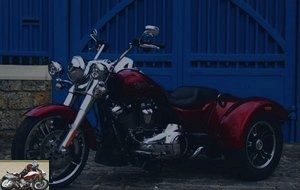
In fact, instead of answering stupid questions, because the machine appeals to the general public, it is sure and do not hope to fall into anonymity or introversion on its handlebars, therefore, instead of that , educate your fans. Tell them the story of the Servi-cars, those 3-wheel Harley-Davidsons launched in 1932 (and as you are a sophisticated person, you won’t be confused with the Harley scooters of 1915, with the basket in the front) , these utility vehicles used by the army, the police, the newspaper and milk deliverers, the craftsmen of all stripes and which helped Harley to overcome the post-1929 crisis by diversifying the business. A little culture never hurts.
Discovery
It’s a Harley, without a doubt. Already it’s marked on it, so that helps. But even without a logo, it’s impossible not to link the Freewheeler to a brand, a story, a genealogy. It’s a Harley.
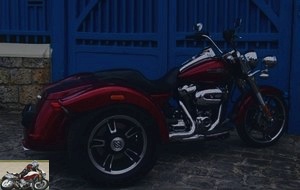
The Freewheeler is a mix of the Harley spirit: from the front, we recognize a Fat Boy front. Seen from the rear, the mudguards hark back to the era of certain Dynas, notably the beautiful Night Trains. And in the middle, between the big V-Twin now Milwaukee-Eight, the abundance of chrome: who can still have a doubt? As for the build quality, it is remarkable.
Thus, Harley-Davidson is doubling its offer in the trike segment. Clearly more equipped and dedicated to touring, but which also weighs 50 kilos more, there is the Tri-Glide Ultra tested on the Den in its 103 variation, is displayed at 37,650 € with the new Milwaukee Eight engine. The Freewheeler has the merit of offering the same concept for almost € 8,000 less.
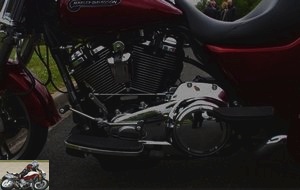
While less bulky than its big brother, even if it is still 1.40 m wide, a figure equivalent to that of a Smart ForTwo, the Freewheeler still has a certain presence, both static and on the road.
In the saddle
For once, let’s say the saddle height, who cares! And I admit that it gives me great pleasure, because with my long legs I always touch the ground and I have a hard time objectively evaluating this aspect of things.
So: at 735mm, the Freewheeler is democratic since once on board, all you have to do is put your feet on the wide running boards and no longer worry about whether you are touching the ground. Or not.
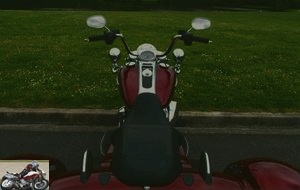
On the handlebars, you realize that you still need a certain size to be perfectly comfortable. If this is not because the space on board is quite generous and when you steer fully, you realize that it takes great arms to complete the idea. Small legs bigger arms equal gibbon build, but don’t make me say what I don’t want. After all, since balance is not a problem, you can step up in the saddle a bit to complete a U-turn..
For the rest, we are in the Harley-Davidson universe: large chrome center console, contactor with typical operation of the brand, which requires having the transponder in your pocket. The large counter seems simple, even simplistic, but the small digital window scrolls through the information: time, range, trips, engine speed and gear engaged. What more ?
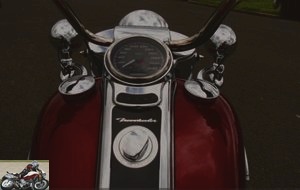
Sun, hold! Because with the big chrome console which holds the false front optic, surrounded by two other headlights (real, them, as provided by the legislation for this kind of machine which, from the front, cannot be confused with a motorcycle), in short, in this abundance of chrome, we see the sky, the sun and sometimes the clouds reflected in front of us. It’s nice.

In the city
With such a machine, you can go to town in 3 ways: to noise, to feeling or, in fact, not to go at all.
The first will quickly get expensive, because it’s like trying to interfere with a Smart. Do only with a friend who follows you, camera in hand, to try to monetize the adventure on Youtube.
The second involves being aware of the size of the craft. We get used to it, except that on the handlebars, there is no indication whether it will pass or not, behind, even by lowering the mirrors to the limit of reasonableness, that is to say at the edge of the watchable.

So we can be tough and decide not to go there at all, in town! Or buy a Street 750 to get the bread. Too bad, but it’s better this way. However, the trunk can store the full range of a lock manufacturer (that’s 99% of motorcycles), although its capacity is limited to 25 kilos.
For the rest: soft throttle control, clutch a little firm, gearbox a little louder than on other Milwaukee Eight tested recently (and it’s starting to make a lot, starting with the last, the CVO Street Glide 114). And the 107 engine is very pleasant by its flexibility, allowing you to stroll on the boulevards in 3rd at a hair over 2000 rpm at 50 km / h.
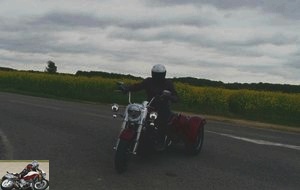
And one of the reasons for the new generation of Milwaukee Eight engines is, of course, to meet new noise and pollution standards. Thus, devoid of any appendage allowing to hide a radiator and fans, our Freewheeler has the "basic" version of block 107, entirely cooled by air. In town, we quickly see that this engine comes to a halt, when stopped or tanked on the ring road, in a "degraded" idle mode, with partial cuts of one of the two cylinders. In the saddle, you can clearly feel the difference in terms of vibrations and it doesn’t seem very pleasant or very "mechanical". Still, the result is there: the 107 doesn’t bake your thighs or gonads, like previous Harley blocks happily did. And that is doubly good: in the short term for pleasure, in the long term so that the human species can survive.
On motorways and main roads
This is certainly the preferred territory of this machine. The ease of handling is real in these conditions, the stability is good, the big curves follow one another with a small movement of the handlebars, everything is fine. The 107 engine, which has already been praised, continues to perform at its best, as to compensate for the excess weight and aerodynamic load, the final drive has been shortened a bit. In fact, where a Harley Touring is spinning at 3000 rpm in 6th gear at 130, the Freewheler is almost at 3500 rpm (and 2390 at 90 km / h). Suddenly, we are almost permanently in the fat of the couple and liveliness is preserved. Vivacity, he said? Yes we can say it.
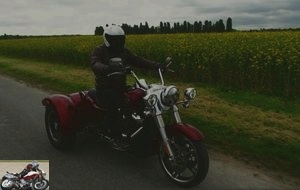
The lack of wind protection and the somewhat distinctive riding position mean that you will naturally feel more comfortable even before you can get flashed. It all depends on the builds and conditions, but personally, I found that a small 110/120 km / h cruising fits well with this machine and with the Harley-Davidson spirit..
And behind, how is it going? We will talk about it again in the comfort section.
On departmental
There, change of register. Led at a leisurely pace, on a not too winding route and on well-paved roads, the Freewheler ensures. But make no mistake: it was designed more for Florida than for the Morvan. Between Daytona Beach and Château-Chinon, the question was quickly resolved.
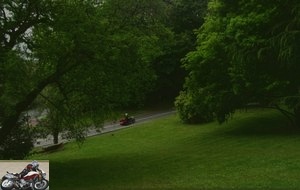
Because, in the series of turns, it requires a little arms. And if we increase the pace, the G-spot becomes its enemy. The point G ? Yes, for gravity. Basically, the Freewheeler’s natural reflex, like any trike, is to pull straight out instead of taking a turn. You can do this by stepping in the desired direction, extending your outside arm to the handlebars, and pulling your body weight inward. Nothing complicated, but be careful: it can get physical. And this is where physically challenged people who set their sights on such a machine must, not revise their judgment, but take into account the involvement that this Freewheeler demands on certain types of routes. Basically, don’t pretend to hit the Alps in two days if you have Nutella in your abs and caramel in your biceps..
Such a driving style meets its requirements: enter a bend slowly, wind up while holding the machine with a small stream of gas and send the mash to the exit. And never get caught.
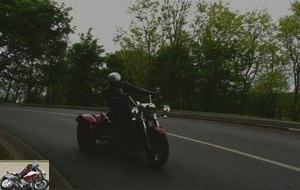
So is this funny? Let’s say they are different pleasures, but no less intense or unpleasant.
And you can play with the machine, but you have to keep a certain reserve: with the generous torque available and the absence of a limited slip differential, it is easy to slide it out of a corner, even more in the wet. But afterwards, when you find yourself at the end of the crossbrake with the postman’s Kangoo or a nice row of plane trees as a perspective, well, good luck! And then on the attack, the rear axle can rebound on the successions of bumps and then, the braking, devoid of ABS (this is not yet mandatory on L5e machines), can block.
Anyway, here’s a friend’s tip from Le Repaire: cool, Raoul.

Part-cycle
To put it simply: a motorcycle front and a car rear. But not just any car: a good American style muscle car. Well yes: rigid rear axle as on a good Mustang (not the last generation, which converted to independent suspensions) and large high-sidewall tires (205/65 x 15), that is also typical of the America than a fresh Coors Light.
Always as little talkative in its technical sheets, Harley-Davidson has its own method to let you know the suspension travel: try coffee grounds, houndstooth or Madame Irma. It is also astonishing that a brand which is close to opulence in many respects shows indigence when we want to go into certain details..
Personal address to Willie G. Davidson: Willie, if ever you open a well paid position in Milwaukee with a company bike included in the package, to write technical sheets, just drop me a mail, buddy. Cheers.
Brakes
Nothing to say about the braking, sufficiently powerful and dosable in all circumstances. It must be said (reminder to those who have spent the last ten years in a cave) that Harleys have made big, big progress in this area. And the Freewheeler does even better: with its specific architecture, it has two discs on the rear axle. Power and dosage: the count is good.
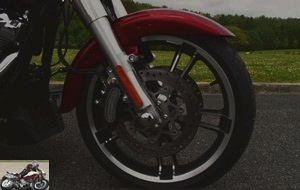
As we said, no ABS, at the same time, given the contact surface on the ground, we made nice saves without blocking. Let’s face it, though, we didn’t ride too much in the rain.
Comfort and duo
The glass, you see it half empty or half full. Because the question of comfort is a bit thorny. Seen like this, placed in the parking lot, the Freewheeler looks even more comfortable than the latest creation from Ligne Roset. And when you get on the handlebars, the saddle is generous, everything is fine. Of course, in solo, the bouncing rear end spoils the pleasure a little and, depending on the habitat and the chosen rhythm, you will have to work a little. But remember that the vocation of such a machine remains easy cruising.
With a passenger, everything changes. First for him. I never quite understood Harley’s insistence on sticking rear-tilted passenger seats, if not, little one, to easily get rid of a boring chick with a solid blow of gas. or, little two, to sell you sissy bars at the price of platinum.
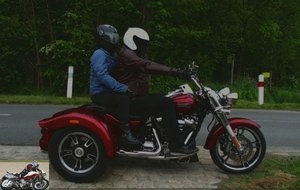
In short: despite the two solid passenger handles, arranged laterally and easily accessible, it turns out that the passenger may want to grip you firmly. Or maybe it’s love. It is good too.
On the small road (we always come back to it!), You will learn communion: because the G-spot tends to want to send the Freewheler into the background, the same effect applies to the passenger who does not have much to hold onto. So he has to get involved: lean to the side of the turn accompanying the rider’s body and struggle to stay in the saddle. Nice ballet.
And for those on the handlebars, the presence of a passenger, or not, also significantly changes the driving experience.
Practical aspects
The trunk has a capacity of 60 liters and is lockable. Good point. However, there is a small bulge on the right side that can accommodate a full face helmet, but the drivetrain reduces space on the left, while the aforementioned trunk hinge prevents a second helmet from being accommodated. Pity. The capacity is correct for a small weekend, but it is not clear how to accommodate side bags or a top case on this machine. As a result, some motorcycles will probably be able to carry more luggage, but if this is a crucial point, then go for the Tri-Glide Ultra..
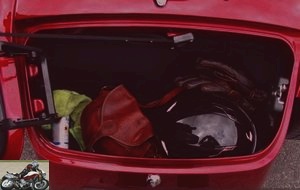
We note the presence of an electric reverse gear, controlled by a button on the left stalk. Always useful, even if we recommend that you do not overdo it! For maneuvering, the Freewheeler pushes easily, but the presence of a side wheel gets in the way when you’re next: it’s best to take it from the front and push it. Finally, the "hand" brake is activated at the foot, behind the left plate.
Consumption / autonomy
Not a lot of town during this test (oddly, I preferred to take my Royal Enfield Bullet to go to the Repaire des Motards office and avoid 3 hours of traffic jam on the periphery) but the ride on the small road and a little urban highway. The result is an average consumption of 7.5 liters / 100, which is reasonable given the size and rolling resistance. The 22.7-liter tank then promises nearly 300 km of autonomy and the indicator on the dashboard is precise.
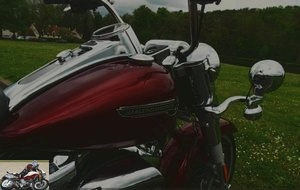
Conclusion
The quiet ride: even more than any other Harley-Davidson, this Freewheler is an ode to cruising, an invitation to landscape contemplation, a call to poetry. Taken in this context, its charm operates quickly and on a nice clear straight line, we sometimes forget that we have two wheels at the back.
Its driveability is real, although it does require a bit of know-how to play with the limits, which is what it was not designed for. In any case, it should be remembered that it is physical on winding departmental roads and mountain passes.
Its greatest asset, however, is to offer the myth and the Harley-Davidson experience to people who do not have a motorcycle license or whose physical condition requires that they be reassured on matters of balance. And in any case, the driving sensations and the pleasure generated by the block 107 Milwaukee Eight make that without a doubt, we do not know if it is a motorbike, not a motorbike or a flying saucer, but what is for sure. is that it’s a real Harley-Davidson.
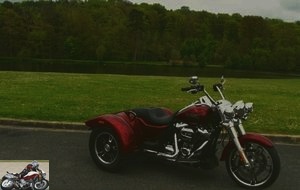
Strong points
- Harley myth accessible to those who do not have a motorcycle license
- Look and finish
- Pleasant 107 engine
- Relative ease of driving
- Chest
- Reverse
- Performance in the shot
- Correct braking
Weak points
- Discomfort on small bumpy roads
- Passenger comfort
- Requires a sacred commitment in the mountains !
- Unlit safe
- Box that does not integrate two full face helmets
- Unpleasant "urban" slow motion
- No ABS even if, in absolute terms, we do very well
The Harley-Davidson Freewheeler technical sheet
Test conditions
- Route: 300 km, mainly small roads and a few Parisian ring roads and urban highways
- Motorcycle mileage: 1.700 km
- Problem encountered: none
Related articles
-
Double disc brake and inverted fork: a more dynamic version of the Sportster 1200 4 “Dark Custom” colors, from € 12,590 Globally, Harley-Davison remains…
-
Harley-Davidson Low Rider S Test
A cruiser in the S Series and Dark Custom range Screamin ‘Eagle Twin Cam 110 V-Twin of 1,801 cm3 delivering 156 Nm And 7! The Dark Custom family…
-
Test: Harley-Davidson Street 750
749 cm3, approx. 57 horses at 7,500 rpm, 59 N.m at 4,000 rpm, 206 kilos dry, from € 6,950 The most accessible way to enter the Harley-Davidson universe…
-
Harley-Davidson Street 750 A2 test
ABS, Euro4 engine, alarm and improved finishing details: from € 7,450 What is this small entry-level custom in a 47 hp flanged version worth? ? Eleven…
-
Harley-Davidson Sport Glide 107 Test
Touring and sport at the same time: absolute versatility according to Harley V2, 1745 cm3, 84 hp at 5400 rpm, 145 Nm at 3250 rpm, 304 dry kilos, from €…
-
Harley-Davidson CVO Street Glide 114 test
V2, 1868 cm3, around 100 hp, 165 Nm, 398 kilos with full fuel, € 39,550 A certain vision of the exception made in Milwaukee and a really punchy 114…
-
Harley-Davidson Road King Special test
V2, 1745 cm3, approx. 90 hp at 5500 rpm, 150 Nm at 3250 rpm, 355 kilos dry, from € 25,390 The Dark Custom spirit touches the queen of the road Discreet…
-
Harley-Davidson Road Glide CVO 117 test
Welcome to excess Harley-Davidson V2, 1923 cm3, 105 hp at 5450 rpm, 166 Nm at 3500 rpm, 385 kilos dry, from € 41,290 From when, too much is enough? What…
-
Harley-Davidson Forty-Eight and A2 test
1202 cm3, approx. 60 horsepower at 5500 rpm, 96 Nm at 3500 rpm, 252 kilos with full tank, from 12,410 € A minimalist and very stylish machine, generous…
-
Harley-Davidson CVO Limited ‘114’ test
New 8-valve Milwaukee-Eight engine for this absolute top of the line from Harley 1870 cm3, approx. 100 horsepower, 166 N.m at 3250 rpm, 414 kilos dry,…
Maybe only on this pre-production model, right?
We would have liked more explanations on this limitation …
This is what is stated at the beginning in the engine part "The ECU limits the top speed on our model to 100 km / h, but the engine is capable of exceeding 120 km / h without this restriction".
There are limitations in some countries (100km / h) and this model is able to limit the speed at ECU level, depending on the country. And this model was therefore limited to 100 km / h.
In France, there is no speed limit for the 125s, and therefore like the Duke, it will be able to take a 120.